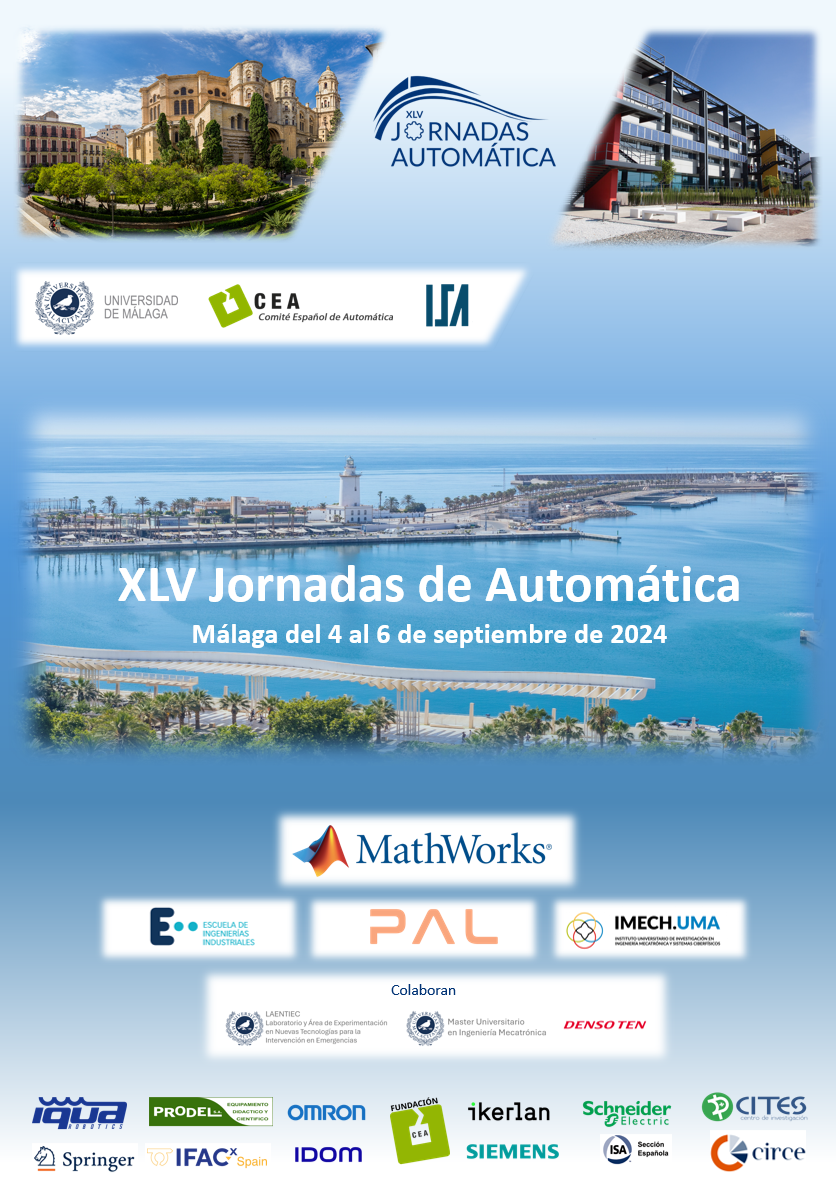Deep Learning para asistencia en rehabilitación con robots mediante demostraciones
DOI:
https://doi.org/10.17979/ja-cea.2024.45.10876Palabras clave:
Tecnología de asistencia e ingeniería de rehabilitación, Ingeniería de rehabilitación y asistencia sanitaria, Toma de decisiones y procesos cognitivos, Automatización centrada en el ser humano, Interfaces inteligentesResumen
El uso de dispositivos robóticos de rehabilitación ha surgido como una solución prometedora para mejorar la recuperación motora durante la rehabilitación. Uno de los retos más significativos durante el uso de estos dispositivos es la capacidad de decidir cuándo proporcionar asistencia al paciente. En este contexto, se ha propuesto una solución basada en Deep Learning para aprender del criterio de un terapeuta cuándo un paciente necesita asistencia. Con el objetivo de desarrollar un modelo que permita generalizar a múltiples situaciones, se ha aplicado una serie de transformaciones a las trayectorias realizadas por los pacientes antes de utilizarlas como entradas al modelo. El modelo propuesto ha sido evaluado utilizando diferentes métricas y ha mostrado una precisión del 93,21% y un F1-Score del 85,05% con el conjunto de datos de validación. Además, el modelo ha alcanzado una precisión del 69,32% y un F1-Score del 63,31% con usuarios que no participaron en el proceso de aprendizaje del modelo.
Referencias
Ahmed, S., Mayo, N. E., Higgins, J., Salbach, N. M., Finch, L., Wood-Dauphinee, S. L., 07 2003. The stroke rehabilitation assessment of movement (stream): A comparison with other measures used to evaluate effects of stroke and rehabilitation. Physical Therapy 83 (7), 617–630. DOI: 10.1093/ptj/83.7.617
Alessandro, L., Olmos, L. E., Bonamico, L., Muzio, D. M., Ahumada, M. H., Russo, M. J., Allegri, R. F., Gianella, M. G., Campora, H., Delorme, R., et al., 2020. Multidisciplinary rehabilitation for adult patients with stroke. Medicina 80 (1), 54–68.
Blank, A. A., French, J. A., Pehlivan, A. U., O’Malley, M. K., 2014. Current trends in robot-assisted upper-limb stroke rehabilitation: promoting patient engagement in therapy. Current physical medicine and rehabilitation reports 2 (3), 184–195. DOI: 10.1007/s40141-014-0056-z
Catalán, J. M., Blanco-Ivorra, A., García-Pérez, J. V., Vales, Y., Martínez-Pascual, D., Ezquerro, S., Garrote, A., Costa, T., Lledó, L. D., García-
Aracil, N., 2023. Patients’ physiological reactions to competitive rehabilitation therapies assisted by robotic devices. Journal of NeuroEngineering and Rehabilitation 20 (41).
Catalán, J. M., García-Pérez, J. V., Blanco, A., Ezquerro, S., Garrote, A., Costa, T., Bertomeu-Motos, A., Díaz, I., García-Aracil, N., 2021. Telerehabilitation versus local rehabilitation therapies assisted by robotic devices: a pilot study with patients. Applied Sciences 11 (14), 6259.
Flach, P. A., 2016. Roc analysis. In: Encyclopedia of machine learning and data mining. Springer, pp. 1–8.
Fong, J., Ocampo, R., Gross, D. P., Tavakoli, M., 2020. Intelligent robotics incorporating machine learning algorithms for improving functional capacity evaluation and occupational rehabilitation. Journal of occupational rehabilitation 30, 362–370.
Friedrich, M., Gittler, G., Halberstadt, Y., Cermak, T., Heiller, I., 1998. Combined exercise and motivation program: effect on the compliance and level of disability of patients with chronic low back pain: a randomized controlled trial. Archives of physical medicine and ehabilitation 79 (5), 475–487. DOI: 10.1016/S0003-9993(98)90059-4
Gulli, A., Pal, S., 2017. Deep learning with Keras. Packt Publishing Ltd.
He, K., Zhang, X., Ren, S., Sun, J., 2015. Delving deep into rectifiers: Surpassing human-level performance on imagenet classification. In: Proceedings of the IEEE international conference on computer vision. pp. 1026–1034.
iDRhA, 2024. https://idrha.es/. URL: https://idrha.es/
Koyejo, O. O., Natarajan, N., Ravikumar, P. K., Dhillon, I. S., 2014. Consistent binary classification with generalized performance metrics. Advances in neural information processing systems 27.
Maclean, N., Pound, P., Wolfe, C., Rudd, A., 2000. A critical review of the concept of patient motivation in the literature on physical rehabilitation. Social Science & Medicine 50 (4), 495–506. DOI: 10.1016/s0277-9536(99)00334-2
Nichols-Larsen, D. S., Clark, P., Zeringue, A., Greenspan, A., Blanton, S., 2005. Factors influencing stroke survivors’ quality of life during subacute recovery. Stroke 36 (7), 1480–1484.
Niu, Z., Zhong, G., Yu, H., 2021. A review on the attention mechanism of deep learning. Neurocomputing 452, 48–62.
Pratiwi, H.,Windarto, A. P., Susliansyah, S., Aria, R. R., Susilowati, S., Rahayu,
Ruby, U., Yendapalli, V., 2020. Binary cross entropy with deep learning technique for image classification. Int. J. Adv. Trends Comput. Sci. Eng 9 (10).
Ruby, U., Yendapalli, V., 2020. Binary cross entropy with deep learning technique for image classification. Int. J. Adv. Trends Comput. Sci. Eng 9 (10).
Stevens, E., Emmett, E.,Wang, Y., C., M., C,W., 2017. The Burden of Stroke in Europe: The challenge for policy makers. Stroke Alliance for Europe.
Ulyanov, D., Vedaldi, A., Lempitsky, V., 2016. Instance normalization: The missing ingredient for fast stylization. arXiv preprint arXiv:1607.08022.
van Peppen, R., Kwakkel, G., H. van der Wel, B., Kollen, B., Hobbelen, J., Buurke, J., Halfens, J., Wagenborg, L., Vogel, M., Berns, M., van Klaveren, R., Hendriks, H., Dekker, J., 2004. Kngf clinical practice guideline for physical therapy in patients with stroke. review of the evidence. Nederlands Tijdschrift voor Fysiotherapie 114 (5).
Descargas
Publicado
Número
Sección
Licencia
Derechos de autor 2024 David Martínez Pascual, Asier Reig-Lozano, Yolanda Vales, José María Catalán Orts, Luís Daniel Lledó Pérez, Nicolás García Aracil

Esta obra está bajo una licencia internacional Creative Commons Atribución-NoComercial-CompartirIgual 4.0.





